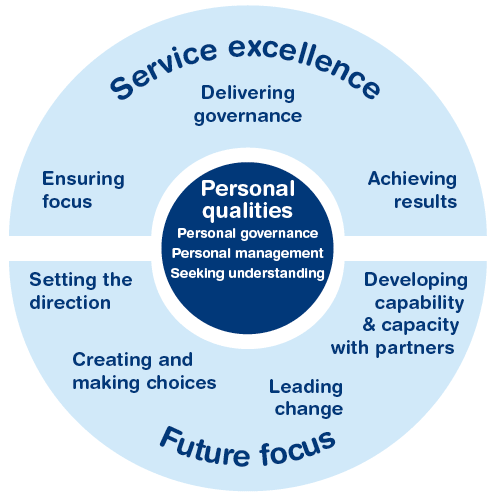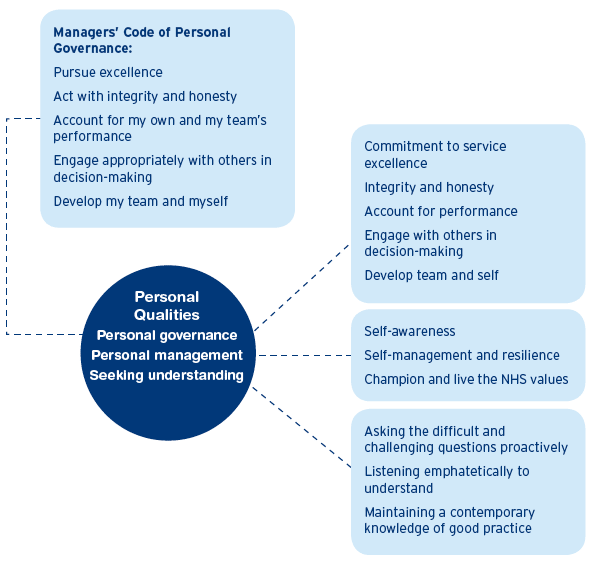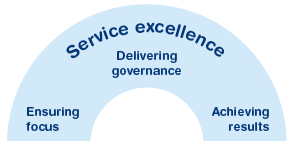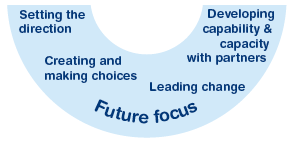Appendix 2: Leadership Qualities and Behaviours
As outlined in Section 3.0 of this document, the framework of leadership qualities and behaviours is set within the strategic context and the leadership challenges facing leaders across NHSScotland ( see figure 1, page 6).
Figure 2: Summary of leadership qualities

In this section, we have provided further description of each of the Leadership Qualities and associated behaviours (in each of the clusters: Personal Qualities; Service Excellence; and Future Focus). They provide a basis for further local development to support:
- Role profiles and person specifications to recruit leaders
- Assessment frameworks for leadership appointments
- Personal and team development planning and review
- Individual/team performance planning and review
- Design of leadership development initiatives
- A potential contractual commitment to personal governance.
Note - Application of the leadership qualities should be linked with other processes, including performance management and personal development planning (as outlined in figure 1). There are also links to be made between the leadership qualities and elements within the Knowledge & Skills Framework.
Personal Qualities
The Personal Qualities are deliberately positioned at the heart of the framework of leadership qualities and behaviours, supporting the notion of authentic leadership. Resilience in particular is a critical personal quality for NHS leaders who, working within a political context, need to be able to manage upwards as well as across the organisation, to manage ambiguity, to take difficult decisions and have difficult conversations.
Personal Governance is one of these personal qualities. The Code of Personal Governance is outlined further in Appendix 3 and provides a code of practice for all leaders and managers in NHSScotland. The Code provides a measure against which individuals can test their decisions and actions. It also provides reassurance to all those served by NHSScotland of the professional standards leaders and managers use in making complex and balanced judgements.

Personal governance (also see Appendix 3 - Code of Personal Governance) |
Descriptors |
Behaviour statements in 360° tool |
- Commitment to service excellence. Integrity and honesty.
- Account for performance.
- Engage with others in decision-making.
- Develop team and self.
See examples of leadership behaviours in table below. |
1. Makes decisions based on patients'/clients' needs.
2. Encourage and give recognition to service excellence.
3. Act with honesty and integrity.
4. Open and transparent in communication.
5. Respect confidentiality of information.
6. Take responsibility for own performance.
7. Take responsibility for team's performance.
8. Model and promote collaborative working.
9. Work with others to create a shared vision.
10. Build and develop effective teams.
11. Take responsibility for personal development.
12. Understand and value cultural differences. |
|
Positive behaviours |
Negative behaviours |
Commitment to service excellence. |
- Puts patients'/clients' needs at the heart of decision-making.
- Challenges decisions which are not based on patients'/clients' needs.
- Recognises and rewards excellence.
- Celebrates success.
- Diagnoses and tackles poor performance and provides appropriate support.
|
- Makes decisions which are not centred on patients'/clients' needs and does not consider the patient/ client point of view.
- Tolerates poor practice and does not tackle poor performance.
- Takes a punitive approach to poor performance, giving no support.
|
Integrity and honesty. |
- Is truthful and honest in dealing with people.
- Takes an open approach to issues.
- Creates a climate of openness in which people can say 'no' as appropriate.
- Respects confidentiality of information consistently.
- Checks out and tackles issues potentially involving dishonesty.
|
- Behaves in a deceptive, dishonest, or manipulative way.
- Hides and encrypts information so that it is not readily available to those who need it.
- Expects others simply to agree and not question actions.
- Leaks or inappropriately shares confidential information.
- Flaunts or ignores issues potentially relating to dishonesty.
|
|
Positive behaviours |
Negative behaviours |
Account for performance. |
- Accepts responsibility and accountability.
- Gives credit where credit is due.
- Challenges micro-management where it is not needed.
- Gives clear, concise, timely explanations - so that there are no surprises.
- Ensures information is organised to explain good and poor performance clearly.
|
- Does not take on responsibility.
- Takes credit for others' work.
- Promotes a culture of dependency.
- Withholds or is late in providing information.
- Information about performance is poorly organised or not provided at all.
|
Engage with others in decision-making. |
- Promotes a spirit of co-operation and inter-dependency.
- Seeks first to understand.
- Encourages meaningful dialogue at the earliest opportunity.
- Develops a shared vision.
- Is flexible in approach.
|
- Is suspicious of others and promotes dependency.
- Seeks first to be understood.
- Decision-making takes place within cliques.
- Does not share information or views with others so that they are left out of the decision-making.
- Is rigid and imposes change.
|
Develop team and self. |
- Builds self-belief and promotes a 'can do' attitude.
- Gives others freedom to make decisions within given authority.
- Lets go of control, enabling others to take calculated risks.
- Inspires trust.
- Values everyone as individuals and respects differences.
- Uses inclusive language.
- Understands and values cultural differences.
- Shows willingness to change and learn from mistakes.
- Encourages behaviour which is consistent with all of the above and challenges those whose behaviour is not.
|
- Undermines other people's confidence.
- Concerned to retain ultimate control at all costs.
- Operates with complex and controlling systems of accountability.
- Is manipulative.
- Expects everyone to be 'the same', i.e. does not respect diversity.
- Uses discriminatory language.
- Is unaware or ignorant of diversity and equality.
- Acts as if they know it all.
- Behaviour which is inappropriate is not challenged.
|
Personal management |
Descriptors |
Behaviour statements in 360° tool |
- Self-awareness.
- Self management & resilience.
- Champion and live the NHS values.
See examples of leadership behaviours in table below. |
13. Show understanding of own strengths and development needs.
14. Seek feedback on own performance and act on it.
15. Recognise and manage own emotions.
16. Recognise emotions in others and help them manage them.
17. Come across as positive and enthusiastic.
18. Behave consistently with the NHS values.
19. Does what s/he says they will do. |
|
Positive behaviours |
Negative behaviours |
Self-awareness. |
- Takes the time to reflect.
- Values honest feedback.
- Is realistic about strengths and development needs
- Seeks out feedback and support where needed.
|
- Does not seek out feedback.
- Does not admit to their weaknesses or development needs.
- Has unrealistic expectations of self and others.
- Does not ask for help or support, tries to go it alone.
|
Self management & resilience. |
- Adopts a positive and enthusiastic approach.
- Is consistently fair in dealing with others
- Is responsible and constructive.
- Demonstrates warmth and is easy to approach.
- Demonstrates mutual respect.
- Recognises and manages own emotions and handles others' emotions with appropriate sensitivity.
- Is resilient especially when faced by setbacks.
|
- Comes across as overly negative and cynical.
- Is temperamental and changeable in mood.
- Is unco-operative.
- Displays vindictive and bullying behaviour.
- Is unapproachable, only approached when essential.
- Lacks respect for others.
- Is insensitive to others' emotions and the impact they have on others.
- Gives up when faced with setbacks.
|
Champion and live the NHS values. |
- Actions are consistent with what they say they will do.
- Does what they say that they will do, even when this means admitting when a promise cannot be kept.
|
- Words and actions do not match.
- Lets others down - does not make it happen.
- Takes actions which are inconsistent with NHS values, even when challenged by others.
|
Seeking understanding |
Descriptors |
Behaviour statements in 360° tool |
- Asking the difficult and challenging questions proactively.
- Listening empathetically to understand.
- Maintaining a contemporary knowledge of good practice.
See examples of leadership behaviours in table below. |
20. Constructively challenge current thinking and practice.
21. Create a climate of support and accountability.
22. Open to new ideas.
23. Actively listen to other people to understand their views.
24. Seek comparisons and best practice from within the NHS.
25. Seek comparisons and best practice from outside the NHS. |
|
Positive behaviours |
Negative behaviours |
Asking the difficult and challenging questions proactively. |
- Seeks to understand why things are done the way they are; does not just accept the status quo.
- Creates a climate of support and accountability.
- Encourages dialogue.
|
- Simply accepts the status quo without question.
- Creates a climate of blame in which people are reluctant to express their views openly.
- Closes down conversation.
|
Listening empathetically to understand. |
- Open to new ideas.
- Shows genuine concern.
- Tests out their understanding and provides summaries as a way of ensuring they are understood.
|
- Closed to new thinking and blocks innovation by others
- Shows superficial interest in others.
- Assumes they have understood and does not check.
|
Maintaining a contemporary knowledge of good practice. |
- Seeks comparisons and encourages change.
- Ensures learning, research and development are integral to improving service delivery.
- Encourages others to share knowledge through networking.
|
- Simply reacts to externally driven change.
- Does not maximise the benefit of learning and R&D to improve service delivery.
- Is suspicious of knowledge sharing and discourages networking.
|
Service excellence
Sitting alongside the personal qualities, there are three leadership qualities aimed at delivering service excellence. These are further described in the table below.

Ensuring focus |
Descriptors |
Behaviour statements in 360° tool |
- Clearly identify and focus attention on the key priorities for delivery.
- Monitor progress against plans, managing pace and stress.
- Takes ownership to plan work on a proactive and realistic basis.
|
26. Recognise key priorities for delivery.
27. Stay focused on key priorities for delivery.
28. Keep people focused on the key priorities for delivery.
29. Anticipate pressures that might interfere with service delivery.
30. Take action to manage pressures that might interfere with service delivery. |
Delivering governance (clinical, staff, financial and corporate) |
- Is concerned to look after the needs of patients, staff and the public, ensuring adherence to appropriate standards of quality and safety.
- Identifies risk and is concerned to manage and balance risk appropriately.
- Maintains professional ethics when confronted with pressure from others and the situation.
|
31. Ensure appropriate standards of safety for staff, patients and public.
32. Consider all aspects of Governance in making decisions. |
Achieving results |
- Create a climate of performance delivery and accountability.
- Set clear goals and objectives.
- Manage performance by recognising good performance and tackling poor performance constructively.
- Balance delivery of results with service quality and excellence.
|
33. Create a culture which is geared to service excellence.
34. Actively manage the performance of all individuals within the team.
35. Constructively tackle complex issues.
36. Achieve a win-win resolution of issues. |
Future focus
Sitting alongside the personal qualities, there are four leadership qualities aimed at ensuring future focus. These are further described in the table below.

Setting the direction |
Descriptors |
Behaviour statements in 360° tool |
- Create purpose with a focus on quality, outcomes and health improvement.
- Shape and articulate the future with enthusiasm.
- Inspire others around the vision of working collaboratively across the public sector.
|
37. Clearly focus on longer-term outcomes.
38. Create a sense of purpose for delivering agreed outcomes.
39. Communicate the vision and make it happen.
40. Create enthusiasm for achieving the agreed outcomes. |
Creating and making choices |
- Think flexibly and foster innovation.
- Make choices in the context of uncertainty and ambiguity.
- Involve and engage others in decision-making and build on their ideas.
- Be prepared to take calculated risks.
- Be politically aware and politically astute in approaching situations and in communicating decisions.
|
41. Think radically and creatively to find solutions to meet goals.
42. Encourage others to be flexible and innovative in finding new ways to improve service delivery.
43. Recognise the uncertainty and ambiguity in situations.
44. Balance the need to make progress and the need to gather more information.
45. Understand the wider context and the underlying politics and realities.
46. Take calculated risks showing awareness of the needs of multiple stakeholders. |
Developing capability and capacity with partners |
Descriptors |
Behaviour statements in 360° tool |
- Build relationships and collaborative partnerships which recognise inter-dependency and which support shared learning.
- Inspire a culture of development across the organisation and in working with partners.
|
47. Work collaboratively with key partners to achieve goals.
48. Build positive relationships with partner teams and organisations.
49. Readily share learnings with partners for mutual benefits.
50. See a development culture as critical to securing long-term goals.
51. Promote an environment within which people are passionate about personal development.
52. Promote an environment within which people are passionate about team development. |
Leading change |
Descriptors |
Behaviour statements in 360° tool |
- Align people, structures, systems and processes to secure goals.
- Seize technological solutions to improve healthcare.
- Inspire and influence others and motivate them to change.
- Engage others in making changes which result in service improvement.
|
53. Identify the full range of effects when implementing change.
54. Address all the implications of the planned change.
55. Secure the right resources and support needed to achieve change.
56. Explore and understand emerging technologies.
57. Actively pursue technological solutions to improve service.
58. Create a momentum and enthusiasm for change through personal visibility and drive. |



